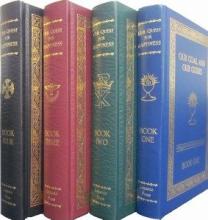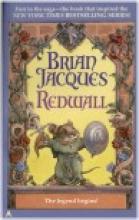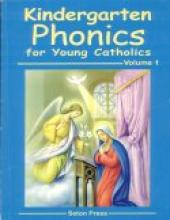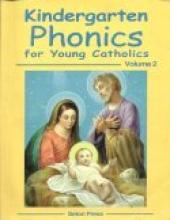No name
My Catholic Speller (Level F)
This text, designed for the 6th-7th grade student, contains lessons for 34 weeks, including 4 quarterly review weeks, an answer key, and teaching instructions. The list words for the first 6 weeks review the various vowel and vowel phonogram sounds in new word lists, and the next 16 weeks focus on prefixes, suffixes, and some spelling trouble spots. The final word lists are devoted to derivatives of Latin and Greek roots, and one lesson on foreign words used in English. The word list for Week 1 is as follows: scrap, scrape, inflate, Africa, betray, clasp, agony, stable, traitor, blaze migrate, obtain, habitat, dedicate, restrain, manna, avid, vast, elevate, and disdain. The word list for Week 34 (the final review) is: mortal, petite, sympathetic, mosquito, vacant, volcano, infinity, suspect, apathy, graduate, dictator, mortify, insect, genetics, provision, invalid, congratulate, valor, multiple, and assist.
The winning apologetics feature of this series is continued in this level. The focus of the quotations from the Early Church Fathers is on Mary and her role in salvation history. Each week the quotation is used for copywork or memory work, or both, and usually contains at least one of the list words. The text includes teaching notes and explanations for each quotation in the back of the book. If you have done as the author suggests and kept an index card file labeled with a topic and the quotation, you will a wonderful apologetics library by the time that you complete the spelling series! Apologetics lessons are a feature of levels B-F.
Copyrights 2002/2003
Donated for review by Catholic Heritage Curricula
The Journal of Ben Uchida
The story helps the reader to understand certain truths about the camps and the consequences of having such camps;
Many of the prisoners, particularly the children were every bit like other Americans in their loyalties, interests and lifestyles and didn't identify with Japan at all.
The camps were a very difficult place to raise children and tended to cause a decline in morals and traditions among the people. A few examples: because the living quarters are so small (one room usually divided with a blanket to accomodate two families), the children roam fairly freely about the camp, allowing for such situations as this: the main character and another boy sneak off to try to see some "naked girls" changing for a play (they are unsuccessful). As far as traditions go, it is very sad to learn that the very traditional Japanese mothers and grandmothers are forced to wear pants because the dust and wind make dresses unmanageable.
The overall injustice of the situation is clearly portrayed as well. Before they leave for the camps, families are forced to sell nearly all of their belongings at ridiculous prices (the author does also introduce us to some kind neighbors and friends who help these families in various ways, such as storing furniture for them). Some of the fathers are taken away for a time to a separate camp because the government thinks they might have specific connections with the Japanese.
After I read the book, I was at first struck that it was very depressing. All of the bad things that happen are not alleviated by a hope in God or even a hero figure on a natural level. Ben Uchida is merely recording the way things are, rather than reflecting on them (with the exception of becoming somewhat cynical). It finally struck me that what the author has done is portray many of the major aspects of the hardships of the internment camp through the eyes of one boy and have all of the different sorts of problems occur within his close circle of friends. I believe that this is somewhat unrealistic and that the book should be read by children old enough to understand this concept. Other than that (and the objectionable incident mentioned above) it really does give the reader a sense of the significance of this terrible event in American history which - even in the politically correct climate of modern America - is largely ignored. The Historical Note section (17 pages) is quite interesting. It includes some factual information about the camps, a number of black and white photos, and a brief history of the treatment of Chinese and Japanese in America (and particularly the discriminatory laws aimed against them over the years). It is also interesting that Franklin Roosevelt (who is so admired by "the left" today) is quite fairly criticized for committing such a crime against American citizens (by Executive Order) and it is interesting that it was Ronald Reagan who attempted to make some sort of retribution (however inadequate) to the Internment Camp survivors.
Our Quest for Happiness
I was introduced to the series as a high school freshman. I enjoyed the text very much at that time (even though I was working with a photocopy). I was equally impressed with the Sophomore text when I taught with it nearly ten years later.
The first book, Our Goal and Our Guides, focuses on understanding our goal in life – attaining Heaven – and spiritual and doctrinal issues that are related to that goal (such as the roles of faith and reason, the liturgical year, the Blessed Trinity, the Fall, and Salvation through Christ).
The second book, Through Christ Our Lord, studies the life of Our Lord in great detail - covering the Old Testament time of waiting for Christ, the basic events of Christ's life, a detailed study of Christ's Death and Resurrection, the Eucharist and the Mass, the Sacraments and following Christ today.
The Ark and the Dove (Book Three) covers the Catholic Church and the Holy Spirit.
Towards the Eternal Commencement is designed especially to prepare graduating seniors as they go out into the world. It covers Our Lady; considerations about death and the afterlife (best reflected upon earlier in life!); vocations; those commandments, virtues and teachings important for "building a better world" and a segment on Apologetics.
Mossflower
Martin the Warrior, a bard-like mouse named Gonff and Dinny the mole leave to find and bring back Boar the fighter. They encounter many adventures along the way, meeting friends and foes, leaving the woodlanders to fend off the increasingly maddened Tsarmina. They do find Boar but his destiny lies in the defeat of an evil sea rat, not in his return to Mossflower. He forges a sword for Martin, however, from the fires of Salamandastron (which is really not a volcano but a huge forge in the mountain) and charges Martin with the duty of the defeat of Tsarmina in his place.
Martin and his friends return to Mossflower just as a plan to flood the evil cat's castle is underway. With Martin's battle plan, the cat's castle is destroyed and the army subdued. Martin himself battles the cat and defeats her. In the end, the mice plan to build an abbey there in the woods dedicated to peace and designed for the protection of the woodlanders. Martin becomes a legend and his saga told to all successive ages of Mossflower inhabitants.
There are many similarities to the original Redwall story, such as a thoroughly evil antagonist, the hero away on a quest during most of the story, the quest ending in finding a sword and a battle between so-called peaceful creatures and trained armies. In this story, however, the hero Martin is portrayed as a noble warrior from the beginning. He has great courage and chivalry and is proven time after time. Another pleasant part of this story is the bard mouse Gonff. He is a delightful character, making up songs and poetry at every turn in the story. The woodlanders are quite ingenious in their resistance to the wild cats (squirrel archers, otter commanders and tunneling moles). I kept thinking that they were doing pretty well without Boar the Fighter. I still found the dialogue trite at times and the plot pretty obvious. When Tsarmina starts to have nightmares about water, we know she's going to die in water.
Mossflower was a good prequel to Redwall in that references made in the first book were explained and the stage set for other stories. Other books in the series suggested by this story include the titles Salamandastron, Martin the Warrior, Luke (father of Martin), Mattimeo (son of Matthias) and more. They all have similar themes in the defeat of evil rats or other vermin by the peaceful, good woodlanders.
Redwall
Redwall (additional review)
One of the abbey mice, Matthias becomes an unlikely hero, rescuing captive field mice, solving mysterious riddles of prophecy, fighting warlike sparrows, killing a huge adder and finally facing and defeating Cluny in one last show-down. Most of this action does not take place in defense of the abbey but on Matthias' quest for the famous sword of an ancient defender of Mossflower: Martin the Warrior. Through one of the prophecies Matthias discovers that Martin had foreseen the days of the rats' attack and Matthias' heroic part of it. He had hidden the sword for Matthias to find and Matthias feels the safety of the abbey rests on this sword alone. Of course it isn't where Martin left it so Matthias must go questing to find it.
When I first read this book several years ago, I was greatly disappointed. It received rave reviews in book catalogs and from 4th and 5th grade teachers everywhere. But, I found the story much too obvious and the writing weak. The dialogue was a distasteful modern sarcastic banter. The plot was full of too many coincidences and no real surprises. The hero showed no signs of heroic virtue, or any other virtue, before he took a central role in the defense of the abbey.
Recently, through the urging of some friends of my children, my husband and I read Redwall aloud to our children. To my surprise, the story, brought to life by my husband reading the voices, was not as stale as I had first thought. The children loved it. Yes, Matthias had no great obvious character from which to draw his heroism but that made him more loveable to my children. He was an ordinary, awkward nobody who rose to greatness and defeated the greatest of evils. He was like them, and yet found the ability to wield a sword. This afforded a great opportunity for discussion about the source of our strength for battling evil.
Fortunately, while they play Matthias and company, they haven't forgotten Jim Hawkins or Peter, Susan, Edmund and Lucy. While I thought the book a somewhat inferior literary effort, it has continued to increase their excitement about reading and storytelling and has not ruined their taste for finer pieces.
Kindergarten Phonics for Young Catholics
Unit one has twenty five lessons. The first eleven are Listening skills (stories and poems), Visual Discrimination (broad similarities, detailed similarities and detailed differences), and Motor Skills (straight and curved lines, detailed dashed, detailed straight, and slanted lines and geometric shapes).
The next nine lessons are on auditory/visual discrimination. There are then three lessons on visual discrimination involving capital and lower case letters, letter identification and tracing. Then there is a another motor skills lesson and one on nursery Rhymes.
Unit Two is the beginning of learning phonics. The first few lessons are on the alphabet. Then on to letter recognition and identifying partner letters (capital and lower case). There are five lessons on motor and visuals skills.
After this the letter lessons begin. Each lesson begins with an intro to the letter. For example, the first letter taught is "S". So for "S" there are five lessons. The first is printing. The next: initial sound and printing. The third is letter discrimination. The fourth is initial sound and printing. The fifth and final lesson is final sound and printing.
Ther next letter taught is "T". After this there is a review of "S" and "T". After every two letters, there is a review of those two letters. After every four letters , there is a review of the four letters.
Unit Two covers the following letters: S,T,B,H,M,K,J,F,G,L, and D.
Kindergarten Phonics for Young Catholics
This volume begins with Unit three. It reviews the Alphabet sound list. Then it covers the following letters: N (including a N/M discrimination), W, C, R, P, Q, V, X, Y, Z. The lessons are the same setup as in Volume 1 (as explained above for the letter "S").
Unit four introduces the vowels. It begins by reviewing the consonants. Then it introduces Short "A". The lessons are as follows for Short "A". First is: recognizing the short sound of Aa. Then Short Vowel Aa. Then blending consonants with the short sound of Aa. Then Short Vowel Aa. Finally the short Aa sound in sentences. This is repeated for Short E, I, O and U. There are reviews after every two vowel sounds taught.
Unit 5 begins by reviewing consonants and short vowels. Then it teaches the two sounds of "C" and "G". Then it begins the long vowels.
It begins in with A. The lessons go as follows: First recognizing the long sound of Aa. Then discriminating between long and short A. Then blending consents with long A. Then again recognizing sound of the long and short A. Then it goes on to E, I, O, U long vowels. Reviews after *each* vowel.
The next section teaches consonant blends like SM, CR, PL, TR, GL, ST as initial sounds. Then final sound consonant blends like CK, NG, MP, SK, NK, and ST. Then the digraph TH is taught and the difference between T and TH.
The final section of volume two is about Y as a vowel. There are three lessons here involving Y with A, with E, and with I in one or two syllable words. The final two lessons are reading a little story about a puppy and answering questions for comprehension.







